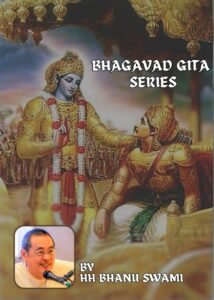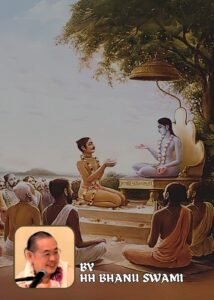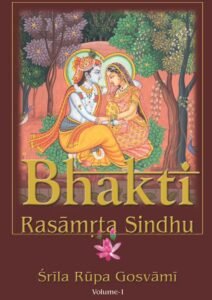Srimad Bhagavatam – 1.13.54 | HH Bhanu Swami Maharaj | ISKCON Chennai | April 15, 2025 |
Om Namo Bhagavate Vāsudevāya
Om Namo Bhagavate Vāsudevāya
Om Namo Bhagavate Vāsudevāya
nama om vishnu-padaya krishna-preshthaya bhu-tale
srimate bhaktivedanta-svamin iti namine
namas te sarasvate deve gaura-vani-pracharine
nirvishesha-shunyavadi-pashchatya-desha-tarine
jaya sri-krishna-chaitanya
prabhu nityananda
sri-adwaita gadadhara
shrivasadi-gaura-bhakta-vrinda
Hare Krishna Hare Krishna Krishna Krishna Hare Hare
Hare Rama Hare Rama Rama Rama Hare Hare
Reading from Srimad Bhagavatham Canto 1 Chapter 13 Verse 54.
ŚB 1.13.54
जितासनो जितश्वास: प्रत्याहृतषडिन्द्रिय: ।
हरिभावनया ध्वस्तरज:सत्त्वतमोमल: ॥ ५४ ॥
jitāsano jita-śvāsaḥ
pratyāhṛta-ṣaḍ-indriyaḥ
hari-bhāvanayā dhvasta-
rajaḥ-sattva-tamo-malaḥ
Synonyms
jita-āsanaḥ — one who has controlled the sitting posture; jita-śvāsaḥ — one who has controlled the breathing process; pratyāhṛta — turning back; ṣaṭ — six; indriyaḥ — senses; hari — the Absolute Personality of Godhead; bhāvanayā — absorbed in; dhvasta — conquered; rajaḥ — passion; sattva — goodness; tamaḥ — ignorance; malaḥ — contaminations.
Translation
One who has controlled the sitting postures [the yogic āsanas] and the breathing process can turn the senses toward the Absolute Personality of Godhead and thus become immune to the contaminations of the modes of material nature, namely mundane goodness, passion and ignorance.
Purport
The preliminary activities of the way of yoga are āsana, prāṇāyāma, pratyāhāra, dhyāna, dhāraṇā, etc. Mahārāja Dhṛtarāṣṭra was to attain success in those preliminary actions because he was seated in a sanctified place and was concentrating upon one objective, namely the Supreme Personality of Godhead (Hari). Thus all his senses were being engaged in the service of the Lord. This process directly helps the devotee to get freedom from the contaminations of the three material modes of nature. Even the highest mode, the material mode of goodness, is also a cause of material bondage, and what to speak of the other qualities, namely passion and ignorance. Passion and ignorance increase the material propensities of hankering for material enjoyment, and a strong sense of lust provokes the accumulation of wealth and power. One who has conquered these two base mentalities and has raised himself to the platform of goodness, which is full of knowledge and morality, cannot also control the senses, namely the eyes, the tongue, the nose, the ear and touch. But one who has surrendered himself unto the lotus feet of Lord Hari, as above mentioned, can transcend all influences of the modes of material nature and be fixed in the service of the Lord. The bhakti-yoga process, therefore, directly applies the senses to the loving service of the Lord. This prohibits the performer from engaging in material activities. This process of turning the senses from material attachment to the loving transcendental service of the Lord is called pratyāhāra, and the very process is called prāṇāyāma, ultimately ending in samādhi, or absorption in pleasing the Supreme Lord Hari by all means.
HH Bhanu Swami Maharaj:
So here we have a description of the yoga process particularly asana and pranayama and pratyahara. So, this is what we call the ashtanga process with eight parts. And of course, the devotees don’t recommend this process. It is practiced by some but very very difficult. But we see that Dhrtarashtra was able to practice. So, particularly in this age of Kali, it’s less likely that people can follow this process properly. So the process is largely not devotional. But here in this verse we see that ‘Hari-bhavanaya’, by thinking of the Lord, he destroyed all contaminations of the gunas. If we look among the niyamas, the second anga of ashtanga Yoga, among those angas is ‘Ishvara Pranidhana’ or worship of the Lord. So the process of ashtanga Yoga does not reject the presence of the Lord. At the same time, we do not classify this as Bhakti. So worship of the Lord is there, but is simply part of the process of ashtanga Yoga. So it assists the process of ashtanga Yoga.
When we do Bhakti Yoga, Bhakti is not assisting anything. It is practiced independent of other processes. Other processes may assist, but also not necessary. So here we have the process of ashtanga Yoga and they’re also worshipping the Lord. And of course, that worship itself is not pure. So why are they worshipping the Lord? Because by worshipping the Lord they get liberation. So pure Bhakti rejects liberation as well as material enjoyment. So the Bhakti is secondary and also not pure. So of course, it’s also a necessary factor in this process. Without worship of the Lord, the yogi cannot get liberation. So, it’s a secondary process, nevertheless if he doesn’t do it, he can’t get his goal.
So the position of the yogi is, he accepts the Lord but he accepts them for ultimately rejecting the Lord and merging in Brahman. So in this verse, it explains by meditating on the Lord he was able to destroy the gunas. So in other words, by worshipping the Lord, his process of getting liberation became easier. And without worshipping the Lord, he actually cannot get liberation.
The same applies to the process of Jnana. Without worship of the Lord, the Jnani cannot get liberation. So the Jnani, if he wants liberation, has to worship the Lord. So, in both these processes, there’s also a dependence on Bhakti. But it is not pure Bhakti. And it’s secondary to their main process and goal.
So, on the other hand when we talk about Bhakti, we’re talking about Bhakti as the main process. The activities may appear similar. So we have hearing, chanting, remembering, deity worship. And the Yogi can do the same thing. But we should not equate and say okay the Yogi is also doing Bhakti. Of course, it is Bhakti, but it’s different. So, the devotee is doing Bhakti as the main process.
Some devotees may do Bhakti as the main process but they may also do it impurely, they may have desire for liberation, material benefits etc… Even that mixed Bhakti is preferable to the Yogi with his little bit of Bhakti. So the Yogi can get liberation. The devotee who does mixed Bhakti, he can get Sarupya or Salokya. So, it’s also considered liberation but it’s a better type of liberation than Sayujya. But one who does pure Bhakti then he gets something superior to that. So, what does the devotee get? He gets Prema.
So, therefore, from the beginning Rupa Goswami advises us, we should practice pure Bhakti. So, no mixture. This does not forbid us from practicing some Karma Yoga or some Jnana Yoga. We can practice those things if they remain minor and they don’t contaminate the Bhakti. And for that reason, in the definition of pure Bhakti Rupa Goswami says, ‘Jnana Karma-adi anavartam’, that it’s not obstructed by Karma or Jnana or other process. So it can be done but it should not obstruct the process of pure Bhakti. So, one obstruction is that, we can have other desires then the Bhakti becomes impure, so that’s an obstruction. So we also do some Karma Yoga but then we develop desire for material prosperity, so that becomes contamination. We do Bhakti Yoga plus we do a little ashtanga Yoga but we also have desire for liberation, that becomes obstacle.
But we can do Bhakti and we do a little ashtanga Yoga but if we have no desire for liberation, then fine, we can do it. Of course, we can ask the question why would he actually do ashtanga Yoga at all, if he has no desire for liberation. So certain of the practices of ashtanga Yoga may be favourable for controlling his mind etc., his senses. So therefore, it’s permitted. And similarly, one can do Karma Yoga. Of course, ultimately, we don’t have to do Karma Yoga, but we may do it to support our Bhakti. But when we become very interested in the Karma Yoga and we start developing the goals of Karma Yoga- maintaining Sattva, going to Svarga Loka etc., then that becomes obstacle. Of course, then we can say well why do we do Karma Yoga at all, since it’s a waste of time, just do Bhakti. So, one answer is, if it doesn’t distract one, one can do it easily, one doesn’t have any material desires, one can do it to set an example for people who are not devotees. Or we can utilize the rules of Karma Yoga to assist Bhakti. So in the rules for Karma Yoga, there are rules for cleanliness, rules for family conduct etc., so those would be useful for the devotee. So to that extent the devotee can practice Karma Yoga as well. But where it becomes an obstruction, taking too much time, developing material desires etc.., then it has to be rejected.
Of course here, with this particular section of verses, Dhrtarashtra is performing mainly ashtanga Yoga. And he is doing a little Bhakti to get rid of his contaminations. So, this is one type of person with a certain type of qualification and faith. Others will choose other processes. But Krishna is advising us, better to choose Bhakti. But those who don’t have faith in the process of Bhakti, will choose these other processes. So that’s why we see Dhrtarashtra doing this Yoga, would be easier for him just to chant Hare Krishna. But he did not have faith in the name. And therefore, he carries out this difficult process. To his credit, at least, he meditated on the Lord. So therefore, he got some result from his Yoga.
Hare Krsna!
Q&A
1) Hare Krishna. If Bhakti is higher than other processes, Ashtanga yoga or similar to that, then why we follow samskaras for the Grahastas starting from naming ceremony up to death ceremony we need brahmanas to conduct all these ceremonies. Does the devotee need to follow samskaras permitted they have a strong faith, that will take longer time but still has to go through all these samskaras even recommended by our ISKCON movement? why is it like that?
So of course the devotees are not obliged to practice anything except Bhakti but they also have material bodies and of course if they are married, then they have to support a family. So we should have some rules for this. So Bhakti does not give rules but Karma Yoga gives rules for that so, it’s convenient to follow those rules rather than no rules, because it’s at least scriptural. But we should always practice without being too attached. So we think if I don’t follow all these rules exactly then I will get some great misfortune that’s contamination. So we do what is favourable for a particular situation later on we may also give up those rules.
Devotees: Grantharaj Srimad Bhagavatahm ki jai, HH Bhanu Swami Maharaj Ki Jai


